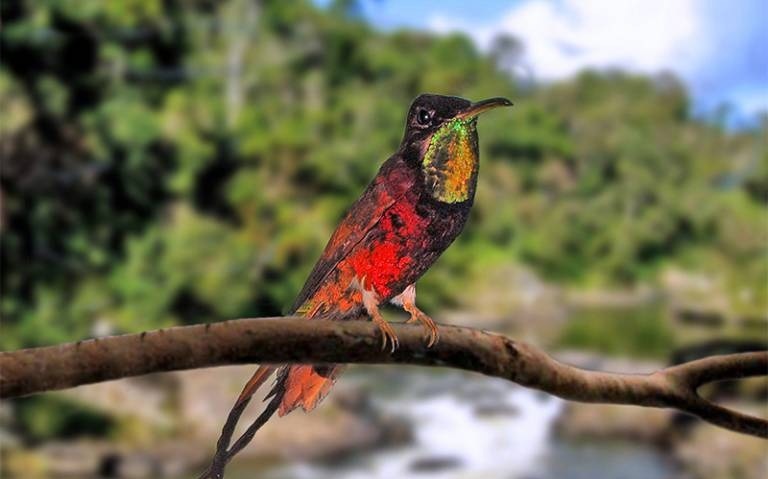According to a recent study headed by a UCL researcher, climate change is likely to rapidly push species beyond tipping points as their geographic ranges reach unanticipated temperatures.
 Fiery topaz (Topaza pyra), a South American hummingbird which is expected to be exposed to temperatures it has never experienced before across most of its range within a single decade. Image Credit: Hectonichus on Wikimedia Commons (CC BY-SA 4.0)
Fiery topaz (Topaza pyra), a South American hummingbird which is expected to be exposed to temperatures it has never experienced before across most of its range within a single decade. Image Credit: Hectonichus on Wikimedia Commons (CC BY-SA 4.0)
The new study published in Nature Ecology & Evolution predicts when and where climate change will expose species worldwide to potentially deadly temperatures.
The researchers from UCL, the University of Cape Town, the University of Connecticut, and the University of Buffalo examined data from over 35,000 species of animals (including mammals, birds, reptiles, amphibians, fish, corals, cephalopods, and plankton) and seagrasses from every continent and ocean basin, as well as climate projections up to 2100.
The researchers looked into when areas within each species’ geographical range will pass a thermal exposure threshold, defined as the first five consecutive years when temperatures continuously exceeded the most extreme monthly temperature encountered by a species across its geographic range in recent history (1850–2014).
Once the thermal exposure threshold is exceeded, the animal does not necessarily die out. Still, there is no evidence that it can withstand the higher temperatures—that is, the research predicts that many species will face a sudden loss of habitat as a result of future climate change.
The researchers discovered a continuous trend in which many animals’ thermal exposure thresholds will be crossed across a large portion of their geographic range within the same decade.
It is unlikely that climate change will gradually make environments more difficult for animals to survive in. Instead, for many animals, large swaths of their geographic range are likely to become unfamiliarly hot in a short span of time. While some animals may be able to survive these higher temperatures, many other animals will need to move to cooler regions or evolve to adapt, which they likely cannot do in such short timeframes.
Dr. Alex Pigot, Study Lead Author, Centre for Biodiversity & Environment Research, UCL Biosciences, University College London
Dr. Alex Pigot adds, “Our findings suggest that once we start to notice that a species is suffering under unfamiliar conditions, there may be very little time before most of its range becomes inhospitable, so it’s important that we identify in advance which species may be at risk in coming decades.”
The researchers discovered that the extent of global warming makes a significant difference: if the planet warms by 1.5 °C, 15% of the species studied will be at risk of experiencing unusually hot temperatures across at least 30% of their existing geographic range in a single decade, but this doubles to 30% of species if the planet warms by 2.5 °C.
Our study is yet another example of why we need to urgently reduce carbon emissions to mitigate the harmful effects climate change is having on animals and plants, and avoid a massive extinction crisis.
Dr. Alex Pigot, Study Lead Author, Centre for Biodiversity & Environment Research, UCL Biosciences, University College London
The researchers expect that their study may aid in the focus of conservation efforts because their data provides an early warning system that shows when and where specific animals are likely to be in danger.
In the past, we’ve had snapshots to show the impact of climate change, but here we are presenting the data more like a film, where you can see the changes unfold over time. This shows that for many species the risk is a bit like everything, everywhere, all at once. By animating this process, we hope to help direct conservation efforts before it’s too late, while also showing the potentially catastrophic consequences of letting climate change continue unchecked.
Dr. Christopher Trisos, Study Co-Author, African Climate and Development Initiative, University of Cape Town
The scientists suggest that this pattern of abrupt exposure may be an inevitable aspect of living on a round planet—because of the shape of the Earth, there is more area accessible to species in environments near the hot end of what they are used to, like in low-lying areas or close the equator.
A recent study by the same lead authors discovered that even if one stops climate change and allows global temperatures to peak and begin to fall, the hazards to biodiversity could last for decades. They discovered that many species confronting unexpected temperatures would be living with other animals suffering similar temperature shocks in another study, which could pose serious dangers to local ecosystem function.
the Royal Society, the Natural Environment Research Council, the National Science Foundation (US), the African Academy of Sciences, and NASA funded the study.
Journal Reference:
Pigot, A. L., et al. (2023). Abrupt expansion of climate change risks for species globally. Nature Ecology & Evolution. doi.org/10.1038/s41559-023-02070-4.